By David T. Phelan
Fire service apparatus advances can be divided into numerous areas and according to numerous benchmarks often tied to operational safety. Providing an increased margin of safety has driven practically every aerial apparatus change and advance. Today’s aerial apparatus are infinitely safer than the aerial apparatus of more than 25 years ago and measurably safer than aerials that are only 10 to 15 years old.
What does this have to do with aerial apparatus inspection, testing, and maintenance? Practically everything! The designed safety of any apparatus depends on the purchaser’s (your fire department’s) unwavering commitment to provide ongoing maintenance to keep the operational safety level as close as possible to the original design safety level. A fire department commitment to a continuous inspection, testing, and maintenance process is one way to accomplish this. Whether you operate a circa 1955 Calavar Firebird or just took delivery of a 2014 super aerial, you want to operate only with a properly inspected, tested, and maintained apparatus for peak performance and safety.
Maintenance
Let’s clear the air about one popular fire service myth: A small department that doesn’t see lots of fires or use its aerial apparatus “all the time” doesn’t need to worry about maintenance. Nothing could be further from the truth! The reality is that every single aerial apparatus needs regular maintenance even if it is infrequently operated.
Retaining your aerial apparatus’ designed safety depends on your agency strictly following a regular inspection, testing, and maintenance schedule. Fire apparatus maintenance is the continuous and ongoing process of ensuring that equipment, features, and components remain as serviceable as when they were new. Maintaining means manually counteracting the effects of aging and wear, slowing down time as much as possible. In the fire service, this not only extends the equipment’s operational life but also ensures complete operational readiness and safety at a moment’s notice. Although maintaining your aerial apparatus can be as simple as washing it, it can also be more extensive and require specialized training and tools. Below, I address maintenance items that your company or in-house personnel can perform with a minimum of tools or specialized knowledge.
Testing
This is another component of the responsible overall apparatus ownership. Although much of aerial testing requires specialized tools, training, and experience, some end users can perform “tests” without such specialized tools or training. This does not replace the necessary comprehensive interval testing. Instead, it encourages using simple tests in your apparatus inspection process to benchmark a developing problem that may require specialized resources to correct.
Inspection
Inspection is the third of these components and is my primary focus. Whether it’s a conscious effort or not, each operator and aerial crew member performs one type of inspection or another between the gear rack and the seat. Essentially, inspection involves looking at a component and determining if it appears intact and operationally ready for service. When you look at something and observe parts missing, pieces dangling, or something leaking, you must investigate further and take action to correct the problem or remove the item from service until it is properly repaired. Beyond simply looking at the component, you can use a light source and perhaps a shop rag to clear away dirt or grease to better expose the inspection surface.
Visual inspections can range from recognizing a loose shoelace and tying it to remove the trip hazard to observing a missing bolt from a bracket and taking action to replace it and maintain the fastener. Throughout our fire station activity we are constantly, if not subconsciously, inspecting all aspects of our gear, tools, and apparatus. Relative to the aerial apparatus, we will now have a better idea of what it is we are looking at and why.
I will focus on a more in-depth inspection process and presume that the apparatus has already been deemed roadworthy and functional. I want to enhance the quality and value of your agency’s apparatus inspection program, but for now, let’s consider it a company level inspection. I’m taking it for granted that all agencies have some type of regular aerial apparatus inspection program. Whether it’s the weekly check, the Sunday duty, or the rig check, you need to do it consistently and with continuity from one inspection to the next. Mindlessly just doing the rig check because the schedule says so is a dangerous mindset. It is a duty to be performed to enhance fireground safety. Put some serious thought and effort into that responsibility.
Aerial Operation and Maintenance Manual
Where is the operation and maintenance manual for your department’s aerial apparatus? If it’s “locked in the chief’s office” or “across town in the city maintenance garage,” then your agency needs to make a change. Although officers and service technicians must have copies of the manuals, it is equally important that copies be freely available in quarters for all firefighters, engineers, chauffeurs, and officers to review and reference. Is there only one copy left and it must be carefully protected because the manufacturer is out of business? That’s all the more reason to bring that document to the copy center and make and distribute several copies.
I advocate keeping a copy of the aerial manual on the apparatus. To clarify here, I’m not suggesting that departments make copies of those four-inch-thick binders and dedicate precious cabinet space to toting books around the city all day long. Those large binders often contain electrical schematics, detailed specifications, and other reference documents for practically every last component on the apparatus-from the chassis to the body and everything in between. Often, these documents don’t even mention the aerial device; hence, the document we are most interested in is the aerial operations and maintenance manual, which is often about 100 pages long and exclusively focused on the aerial device. A simple review of all the apparatus manuals will quickly disclose which one is the aerial manual.
If you took delivery in only the past few years, this, along with all the other manuals, may be on a CD-ROM. Although the CD-ROM saves a lot of space, it is also easily misplaced or stuffed inside a file folder and filed away with the purchasing documents. Electronic format manuals should be on departmental computers or servers and made available to all members for casual browsing or as part of retraining. Generate at least one hard copy and stow it on the apparatus for field reference. Reproduced copies should also be marked up and annotated based on changes or revisions which the manufacturer may have issued after initial delivery. Additionally, you can easily insert technical service bulletins to keep the document up to date.
The information provided in this article is broad and generic, representing the “best practices” applicable to most of the aerial apparatus currently in service. Any inspection, testing, or maintenance procedures must be performed according to the aerial operations and maintenance manual of your department’s specific apparatus. For example, in discussing operational time testing, generally, you time the full range of the motion from cradled to fully elevated, such as 0° to 75°. But if the manufacturer of your particular aerial specifies you time across a 60° arc, that range and permitted time measurement would prevail.
Stabilizer System: Outriggers and Jacks
Before considering any aerial device operation, first establish the full set and proper deployment of the apparatus stabilizer system. A proper apparatus inspection must evaluate the stabilizer system and any safety interlocks that were built into your specific apparatus. In addition to verifying the proper operation of the stabilizer sensors and interlocks, closely observe the stabilizers’ movement for stuttering, vibration, or squealing, which can all indicate alignment and lubrication issues.
As shown in photos 1-3, there can be electromechanical issues with the sensor circuits that can leave an apparatus without the full interlock safety as designed by the manufacturer. Photo 1 reveals that none of the beams are deployed and all the jacks are fully stowed. However, the tailboard-mounted indicator lamps (photos 2-3) are signaling that three of the four jacks are properly deployed and set for aerial movement, even though none are actually deployed or set. If the officer side front outrigger was properly deployed, in this situation, the aerial could be deployed without limitation, creating an unstable condition and potential tip over.
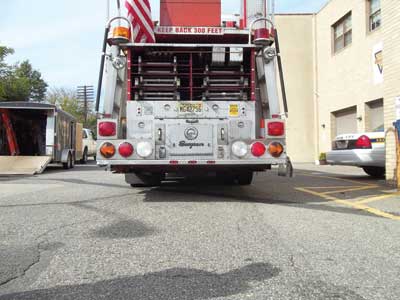 |
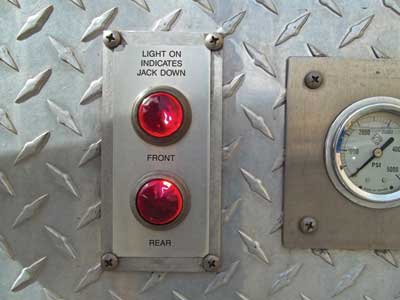 |
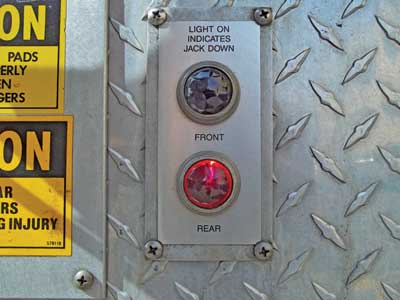 |
| Photos by author |
The fireground is not the place to detect and diagnose such problems: Time is short, and we operate on the expectation that our equipment is in top condition. A prescribed company inspection allows the crews the time to carefully perform an evolution and critique the outcome. You may be surprised at what you find when you have the time and opportunity to exercise your apparatus.
Aerial Cables/Wire Rope
Practically all aerials rely on a system of cables to synchronize and support the fly sections of the aerial device. Operators must consider three essential elements when checking the cables during an inspection: tension, condition, and lubrication. You can verify each of these items without using specialized tools or taking an exceptional amount of time; include them as part of the overall apparatus inspection. Cable tension is formally measured with a specialized tool, a tension gauge; but at the company inspection level, investing in such equipment or training on it is not needed. A contractual service provider can perform this function, comparing the measurements obtained with the aerial manufacturer’s specification. Aerial operators can be fair judges of cable tension based on their experience and observing the overall movement of an aerial. Although proper tensioning is important, at this level, the goal is to identify those cables which excessively slack or whose tension is grossly mismatched with that of the cable on the opposite side (photo 4).
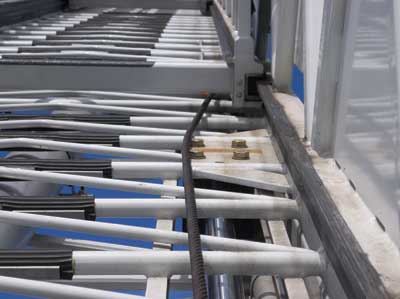
The overall cable condition is another visual inspection in which the operator examines the cables for signs of damage, defects, broken strands, or unraveling (bird-caging). Through regular maintenance and proper operation, the chances of an aerial cable becoming damaged is remote, but it is still possible, and a close inspection should follow any unusual operation, loading, or collision.
Finally, all cables and wire ropes require proper lubrication to ensure longevity and smooth operation. Cable lubrication is likely one of the most misunderstood elements of aerial maintenance, yet it serves a critical purpose. Cable and wire rope have two wear points-the outer circumference that rides in the sheaves and the inner strands that pull and twist against each other as the cable is loaded and unloaded. To provide proper lubrication, ensure that the outer surfaces and inner strands are evenly lubricated.
Lathering with a heavy lubricating grease is absolutely the worst way to lubricate a cable and will provide users with a false sense of the cable’s condition. Furthermore, that heavy coating of grease will attract and hold dirt and debris (photo 5) while concealing visual cues of damage or defect. Depending on the aerial manufacturer, the specific brand and type of approved cable lubricant can vary, but manufacturers generally specify a lightweight cable and chain lubricating oil in a spray or a wipe-on formula.
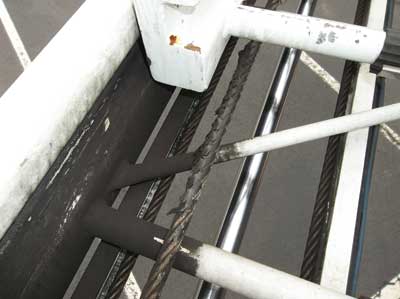
Do not saturate cables so that they drip oil as the aerial is extended or retracted. This does not improve performance or longevity and can create a slip-and-fall safety hazard on the walking surfaces above the aerial turntable and on the rungs.
Ladder Lubrication
Extension and retraction of the aerial device occurs through the work and coordination of hydraulic cylinders and cable systems. Facilitating these movements is the function of the guides and lubrication. Without proper lubrication, the sliding surfaces of the aerial structure will quickly wear and, over time, can shorten the service life of the aerial.
It is too expensive to neglect proper aerial lubrication. The adjustment and replacement of wear blocks and guides is something best left for factory trained personnel, but you still need to regularly keep the lubrication fresh and well distributed. Seeing that there is lubricant on the ladder is not enough. To properly evaluate the lubricant’s quality, you need to get down and run a finger through it. Good lubrication is evenly distributed across the entire bearing or sliding surface and feels moist to the touch, without grit or organic contamination. If the lubricant is gritty, dry, cracking, or crumbly or flakes off when scraped by a fingernail, it is time to renew the surface. If the existing lubricant is hardened and has an almost polished appearance, you need to remove as much of it as possible before applying new lubricating grease. Although this task is messy, it is quite necessary-so be sure not to overlook these areas during your inspection.
Use protective gloves and wooden or plastic tools to assist in removing dried and excess material and to prevent gouging or damaging the protective paint finishes. You can fashion very useful grease removal tools from wooden paint stirrers or even old hotel guest room access cards. With a little cutting and trimming, you can shape these items into custom removal scrapers that can clean a rail section in a single pass. As always, ensure that any surfaces which are stripped are immediately recoated with an even layer of the proper grease or lubricant, according to the aerial maintenance manual.
Time Testing
Although technically a “test,” company personnel can easily perform this using nothing more than a stopwatch. Aerial time testing is the rough equivalent of blood pressure, pulse, and respiration as vital signs of your aerial’s health. In addition to safely carrying a load, the aerial’s prime function is to move personnel and equipment to elevated locations and safely return those resources to the ground. If vital components of the overall hydraulic system were to wear or break down, it would manifest itself in the overall aerial movement, which is best evaluated by timing it through an established sequence.
In addition to pulling a control lever and timing the evolution, the operator and crew will observe the overall movement, listening for unusual sounds and recording the hydraulic system pressure-that is, taking the aerial’s “vital signs.” Document all of this information on the inspection sheet or log so that you can compare it against known acceptable results and to also map trends over weeks or months as you develop a sense of just how your aerial is aging and performing. Your aerial manual will provide the baseline values for your aerial, since there is great variation across the industry.
On some newer apparatus, this information is often printed or posted on or near the pedestal control station; with older apparatus, you definitely must consult the manufacturer’s documents since the values for time and hydraulic pressure can sometimes be spread throughout the manual. A sample log chart (Figure 1) can help you understand what information is to be collected and how to record and compare the results.
Unless your aerial manufacturer specifies otherwise, tolerances of +/- 10 percent are acceptable on any given inspection. Many variables can influence test times and pressures, so we must have some means to accommodate variations, but we should strive to repeat the testing process as uniformly as possible from one shift/week/month to another. The log sheet should be as clear as possible to ensure that all crews are performing the test similarly.
Last, pay attention to the idle speed and revolutions per minute at fast idle during your testing. The hydraulic pump operates off a power takeoff (PTO) from the apparatus engine, and problems and issues in the engine can easily impact aerial performance. Poor fuel quality, clogged injectors, dirty intakes, and restricted exhausts will all have an impact on the overall speed of the apparatus engine that drives the aerial PTO pump, so record these settings also to help explain a situation where aerial performance is dropping off.
Prepiped Aerial Waterway
Prepiped waterways on aerial apparatus rely significantly on proper lubrication and maintenance to ensure that they can deliver elevated streams. The swivels and telescoping seals found on every waterway must be kept fully packed with the proper lubricating grease to prevent leaks and damage to moving parts (photos 6-7). This is especially true with any use, emergency or training, of the prepiped aerial waterway. Whenever water is flowed through the waterway, it erodes the lubrication of the telescoping seal. Although that is a normal occurrence, it is important that you refresh the lubricant after each use.

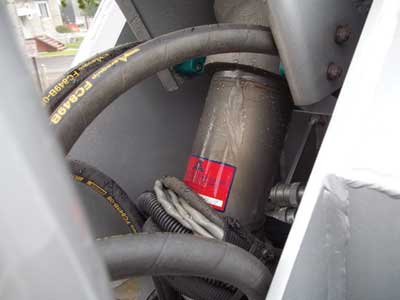
One easy way to facilitate and encourage this practice is to keep the proper waterway lubricant grease gun on the aerial apparatus. This addresses two possible problem areas. First, there is little chance that an operator will grab the wrong grease gun from a firehouse cabinet and use it on the waterway when it was really meant for wheel bearings and universal joints. Second, it facilitates the process of ensuring the waterway is properly lubricated after any use.
Whether it’s a training session or a fireground operation, you can lubricate the seals as part of the break down and pack up of the apparatus. If it is left for “later,” there is an increased chance that somebody will forget to do it or the work will be put off until tomorrow morning and end up never getting done.
Lubricating the waterway isn’t complicated and only takes a few minutes. Why not just encourage it and provide the operator with the appropriate grease gun in one of the compartments?
Displaying 1/2 Page 1, 2, Next>
View Article as Single page
Fire Engineering Archives

